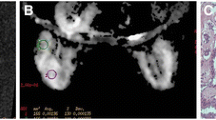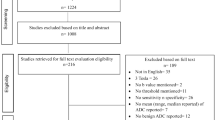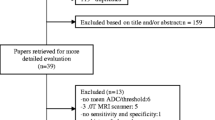Abstract
Objectives
To investigate the impact of background parenchymal enhancement (BPE), amount of fibroglandular tissue (FGT) and menopausal status on apparent diffusion coefficient (ADC) values in differentiation between malignant and benign lesions.
Methods
In this HIPAA-compliant study, mean ADC values of 218 malignant and 130 benign lesions from 288 patients were retrospectively evaluated. The differences in mean ADC values between benign and malignant lesions were calculated within groups stratified by BPE level (high/low), amount of FGT (dense/non-dense) and menopausal status (premenopausal/postmenopausal). Sensitivities and specificities for distinguishing malignant from benign lesions within different groups were compared for statistical significance.
Results
The mean ADC value for malignant lesions was significantly lower compared to that for benign lesions (1.07±0.21 x 10−3 mm2/s vs. 1.53±0.26 x 10−3 mm2/s) (p<0.0001). Using the optimal cut-off point of 1.30 x 10−3 mm2/s, an area under the curve of 0.918 was obtained, with sensitivity and specificity both of 87 %. There was no statistically significant difference in sensitivities and specificities of ADC values between different groups stratified by BPE level, amount of FGT or menopausal status.
Conclusions
Differentiation between benign and malignant lesions on ADC values is not significantly affected by BPE level, amount of FGT or menopausal status.
Key Points
• ADC allows differentiation between benign and malignant lesions.
• ADC is useful for breast cancer diagnosis despite different patient characteristics.
• BPE, FGT or menopause do not significantly affect sensitivity and specificity.






Similar content being viewed by others
Abbreviations
- ADC:
-
Apparent diffusion coefficient
- AUC:
-
Area under the curve
- BIRADS:
-
Breast Imaging Reporting and Data System
- BPE:
-
Background parenchymal enhancement
- DWI:
-
Diffusion-weighted imaging
- DCE:
-
Dynamic contrast-enhancement
- FGT:
-
Fibroglandular tissue
- MRI:
-
Magnetic resonance imaging
- ROC:
-
Receiving operator characteristic
- SD:
-
Standard deviation
References
Mann RM, Balleyguier C, Baltzer PA et al (2015) Breast MRI: EUSOBI recommendations for women's information. Eur Radiol 25:3669–3678
Sardanelli F, Boetes C, Borisch B et al (2010) Magnetic resonance imaging of the breast: recommendations from the EUSOMA working group. Eur J Cancer 46:1296–1316
Kuhl CK, Strobel K, Bieling H, Leutner C, Schild HH, Schrading S (2017) Supplemental Breast MR Imaging Screening of Women with Average Risk of Breast Cancer. Radiology 283:361–370
Lehman CD, Smith RA (2009) The role of MRI in breast cancer screening. J Natl Compr Canc Netw 7:1109–1115
Lourenco AP, Donegan L, Khalil H, Mainiero MB (2014) Improving outcomes of screening breast MRI with practice evolution: initial clinical experience with 3T compared to 1.5T. J Magn Reson Imaging 39:535–539
Partridge SC, DeMartini WB, Kurland BF, Eby PR, White SW, Lehman CD (2009) Quantitative diffusion-weighted imaging as an adjunct to conventional breast MRI for improved positive predictive value. AJR Am J Roentgenol 193:1716–1722
Pinker K, Helbich TH, Morris EA (2017) The potential of multiparametric MRI of the breast. Br J Radiol 90:20160715
European Society of R (2010) White paper on imaging biomarkers. Insights Imaging 1:42–45
Tan SL, Rahmat K, Rozalli FI et al (2014) Differentiation between benign and malignant breast lesions using quantitative diffusion-weighted sequence on 3 T MRI. Clin Radiol 69:63–71
Guo Y, Cai YQ, Cai ZL et al (2002) Differentiation of clinically benign and malignant breast lesions using diffusion-weighted imaging. J Magn Reson Imaging 16:172–178
White NS, McDonald CR, Farid N et al (2014) Diffusion-Weighted Imaging in Cancer: Physical Foundations and Applications of Restriction Spectrum Imaging. Cancer Res 74:4638–4652
Matsubayashi RN, Fujii T, Yasumori K, Muranaka T, Momosaki S (2010) Apparent diffusion coefficient in invasive ductal breast carcinoma: correlation with detailed histologic features and the enhancement ratio on dynamic contrast-enhanced MR images. J Oncol 2010:1–6. https://www.hindawi.com/journals/jo/2010/821048/
Martincich L, Deantoni V, Bertotto I et al (2012) Correlations between diffusion-weighted imaging and breast cancer biomarkers. Eur Radiol 22:1519–1528
Arlinghaus LR, Li X, Rahman AR et al (2011) On the relationship between the apparent diffusion coefficient and extravascular extracellular volume fraction in human breast cancer. Magn Reson Imaging 29:630–638
Partridge SC, Mullins CD, Kurland BF et al (2010) Apparent diffusion coefficient values for discriminating benign and malignant breast MRI lesions: effects of lesion type and size. AJR Am J Roentgenol 194:1664–1673
Caivano R, Villonio A, D’ Antuono F et al (2015) Diffusion weighted imaging and apparent diffusion coefficient in 3 tesla magnetic resonance imaging of breast lesions. Cancer Invest 33:159–164
Suo S, Cheng F, Cao M et al (2017) Multiparametric diffusion-weighted imaging in breast lesions: Association with pathologic diagnosis and prognostic factors. J Magn Reson Imaging 46:740–750
Tsushima Y, Takahashi-Taketomi A, Endo K (2009) Magnetic resonance (MR) differential diagnosis of breast tumors using apparent diffusion coefficient (ADC) on 1.5-T. J Magn Reson Imaging 30:249–255
Kul S, Eyuboglu I, Cansu A, Alhan E (2014) Diagnostic efficacy of the diffusion weighted imaging in the characterization of different types of breast lesions. J Magn Reson Imaging 40:1158–1164
Ei Khouli RH, Jacobs MA, Mezban SD et al (2010) Diffusion-weighted imaging improves the diagnostic accuracy of conventional 3.0-T breast MR imaging. Radiology 256:64–73
Kim JY, Suh HB, Kang HJ et al (2016) Apparent diffusion coefficient of breast cancer and normal fibroglandular tissue in diffusion-weighted imaging: the effects of menstrual cycle and menopausal status. Breast Cancer Res Treat 157:31–40
Cho GY, Moy L, Kim SG et al (2015) Comparison of contrast enhancement and diffusion-weighted magnetic resonance imaging in healthy and cancerous breast tissue. Eur J Radiol 84:1888–1893
Choi YJ, Chen JH, Yu HJ, Li Y, Su MY (2017) Impact of Different Analytic Approaches on the Analysis of the Breast Fibroglandular Tissue Using Diffusion Weighted Imaging. Biomed Res Int 2017:1094354
Clendenen TV, Kim S, Moy L et al (2013) Magnetic resonance imaging (MRI) of hormone-induced breast changes in young premenopausal women. Magn Reson Imaging 31:1–9
Iacconi C, Thakur SB, Dershaw DD, Brooks J, Fry CW, Morris EA (2014) Impact of fibroglandular tissue and background parenchymal enhancement on diffusion weighted imaging of breast lesions. Eur J Radiol 83:2137–2143
Kawamura A, Satake H, Ishigaki S et al (2015) Prediction of background parenchymal enhancement on breast MRI using mammography, ultrasonography, and diffusion-weighted imaging. Nagoya J Med Sci 77:425–437
McDonald ES, Schopp JG, Peacock S et al (2014) Diffusion-weighted MRI: association between patient characteristics and apparent diffusion coefficients of normal breast fibroglandular tissue at 3 T. AJR Am J Roentgenol 202:W496–W502
O'Flynn EA, Wilson RM, Allen SD, Locke I, Scurr E, deSouza NM (2014) Diffusion-weighted imaging of the high-risk breast: Apparent diffusion coefficient values and their relationship to breast density. J Magn Reson Imaging 39:805–811
Partridge SC, Singer L, Sun R et al (2011) Diffusion-weighted MRI: influence of intravoxel fat signal and breast density on breast tumor conspicuity and apparent diffusion coefficient measurements. Magn Reson Imaging 29:1215–1221
Morris EA, Comstock CE, Lee CH, et al. (2013) ACR BI-RADS® magnetic resonance imaging. In: ACR BI-RADS® Atlas, Breast Imaging Reporting and Data System. American College of Radiology, Reston, VA
Youden WJ (1950) Index for rating diagnostic tests. Cancer 3:32–35
Acknowledgements
We would like to thank Joanne Chin for technical editing.
Funding
This study has received funding by Memorial Sloan Kettering Cancer Center Support Grant / NIH Core Grant (P30 CA008748), DOD BCRP W81XWH-09-1-0042 grant, and the Breast Cancer Research Foundation grant of Memorial Sloan Kettering Cancer Center.
Author information
Authors and Affiliations
Corresponding author
Ethics declarations
Guarantor
The scientific guarantor of this publication is Sunitha B. Thakur.
Conflict of interest
The authors of this manuscript declare no relationships with any companies, whose products or services may be related to the subject matter of the article.
Statistics and biometry
One of the authors has significant statistical expertise (Sujata Patil).
Informed consent
Written informed consent was waived by the Institutional Review Board.
Ethical approval
Institutional Review Board approval was obtained.
Study subjects or cohorts overlap
Some study subjects or cohorts have been previously reported in Durando M, Gennaro L, Cho GY et al (2016) Quantitative apparent diffusion coefficient measurement obtained by 3.0Tesla MRI as a potential noninvasive marker of tumor aggressiveness in breast cancer. Eur J Radiol 85:1651-1658. However, different data were used in a different context.
Methodology
• retrospective
• observational
• performed at one institution
Rights and permissions
About this article
Cite this article
Horvat, J.V., Durando, M., Milans, S. et al. Apparent diffusion coefficient mapping using diffusion-weighted MRI: impact of background parenchymal enhancement, amount of fibroglandular tissue and menopausal status on breast cancer diagnosis. Eur Radiol 28, 2516–2524 (2018). https://doi.org/10.1007/s00330-017-5202-4
Received:
Revised:
Accepted:
Published:
Issue Date:
DOI: https://doi.org/10.1007/s00330-017-5202-4




